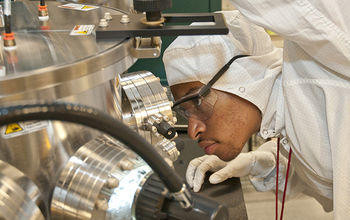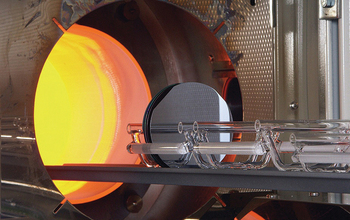All Images
NSF renews investment in National Nanotechnology Coordinated Infrastructure

The Cornell NanoScale Facility (CNF) is one of 16 sites in the NSF-funded National Nanotechnology Coordinated Infrastructure.
As part of its efforts to prepare the future workforce, CNF has hosted hundreds of students through the NSF Research Experiences for Undergraduates (REU) program over the years. CNF REU interns spend ten summer weeks learning all they can about our nano-world, being trained on research tools, and performing their own, sometimes published and patented, research.
Here, student intern Austin Little (2014) works with one of the CNF sputtering systems.Credit: Photograph by Don Tennant, courtesy Melanie-Claire Mallison, Cornell NanoScale Facility
Download the high-resolution JPG version of the image. (582.6 KB)
Use your mouse to right-click (Mac users may need to Ctrl-click) the link above and choose the option that will save the file or target to your computer.

MiNIC, the Midwest Nano Infrastructure Corridor, is one of 16 facilities in the NSF-funded National Nanotechnology Coordinated Infrastructure (NNCI). One of MiNIC's focus areas is quantum information sciences.
MiNIC instrumentation captured this high-resolution electron micrograph of the topological insulator Bi2Te3. This type of material may play a key role in stabilizing the type of quantum devices needed for practical quantum computing.Credit: Andre Mkhoyan, Chemical Engineering and Materials Science, University of Minnesota
Download the high-resolution JPG version of the image. (575.2 KB)
Use your mouse to right-click (Mac users may need to Ctrl-click) the link above and choose the option that will save the file or target to your computer.

MANTH, the Mid-Atlantic Nanotechnology Hub, is one of 16 sites in the NSF-funded National Nanotechnology Coordinated Infrastructure (NNCI).
At the MANTH facility, researchers batch-fabricated microwell cytokine sensors on fused silica wafers. Detection of cytokines is of great interest in understanding inflammatory processes in the body.Credit: Naixin Song, University of Pennsylvania, courtesy George Patrick Watson, University of Pennsylvania
Download the high-resolution PNG version of the image. (1.8 MB)
Use your mouse to right-click (Mac users may need to Ctrl-click) the link above and choose the option that will save the file or target to your computer.

The Cornell NanoScale Facility (CNF) is one of 16 sites in the NSF National Nanotechnology Coordinated Infrastructure.
One of the many state-of-the-art tools in the Cornell NanoScale Facility (CNF) is the Anneal 4 Furnace -- an atmospheric furnace with a 40-inch flat zone capable of processing up to 6-inch diameter wafers. Furnaces are used for growing silicon oxide and depositing polysilicon, silicon nitride, and silicon oxide as well as processes for cleaning silicon wafers before deposition. Such research enables future semiconductor technologies.Credit: Charles Harrington Photography, Courtesy Melanie-Claire Mallison, Cornell NanoScale Facility
Download the high-resolution JPG version of the image. (763.9 KB)
Use your mouse to right-click (Mac users may need to Ctrl-click) the link above and choose the option that will save the file or target to your computer.


